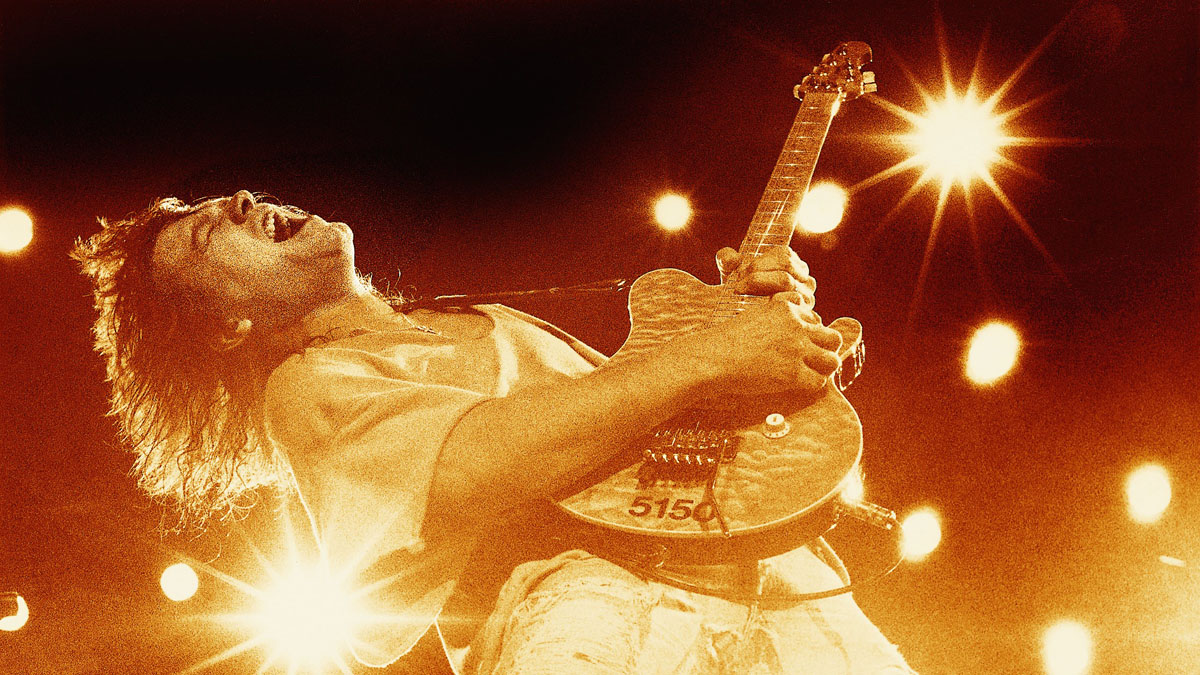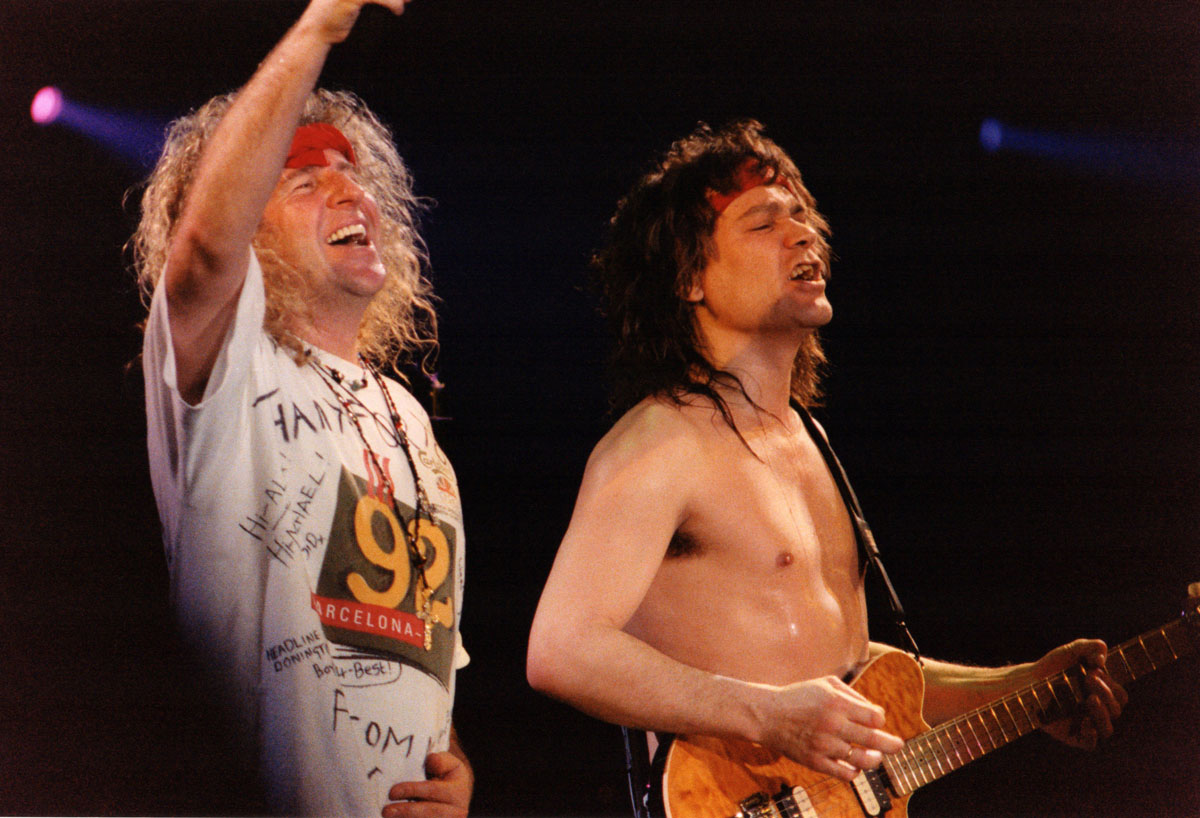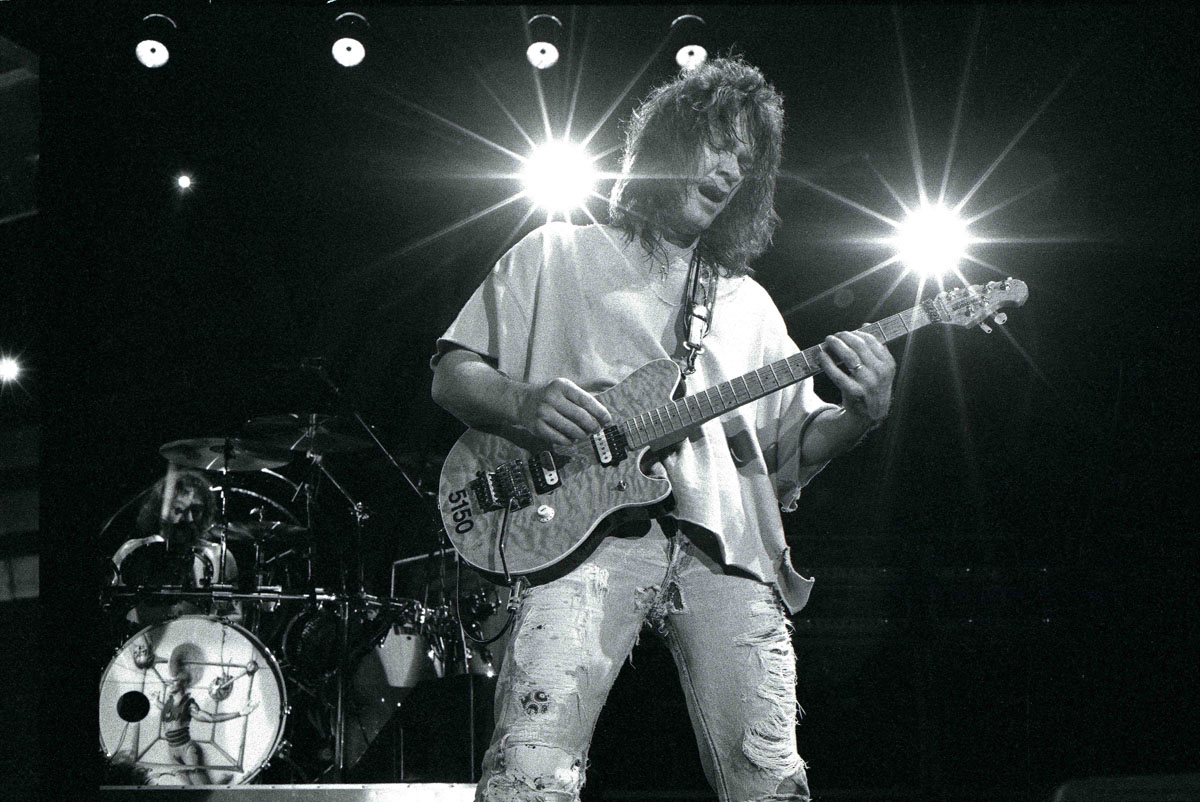Eddie Van Halen goes deep on his approach to tone, technique and guitar design in this classic 1993 Guitarist interview
EVH details the advent of Van Hagar, that time he took a belt sander to a 335, and why Neil Young's Cinnamon Girl is one of his favorite solos of all time

When Van Halen took the Monsters Of Rock show at Donington by storm in 1984, a return visit of the sooner-rather-than-later variety seemed likely. As it is, the UK had to wait nine years to see the band in action, meanwhile enduring the tease of two live videos along the way.
“Actually, it’s not just Britain; it’s Europe altogether… and we’ve never even been to Australia!” laughs Edward Van Halen, obviously not quite believing it himself. “I’m sure a lot of people are really pissed off, goin’, ‘Hey, fuck you – if you’re not going to play, I’m not going to buy your records.’ But that isn’t it at all. It was just an unfortunate chain of events.”
We’re chatting during a break from the band’s rehearsals for the European leg of their forthcoming tour. Whereas most of us have to make do with the local Scout hut or the bass player’s front room, when you’re Van Halen you hire Docklands Arena for the week.
But back to the plot. Just what was this terrible chain of events that has kept Ed and the boys from our shores for so long?
“Well, when Roth quit the band, it kinda left us going ‘Hmmmm…’ In the beginning, I was planning on doing a solo record with Alex [Van Halen] and Mike [Anthony] but having a different singer on each track: Joe Cocker, Phil Collins, Pete Townshend. I was thinking of doing something strange.
“It wouldn’t be Van Halen, but it would be Alex, Mike and me with all these different singers. But logistically, it would probably just be getting finished now, what with everyone’s scheduling, y’know? So we nixed that idea and Alex said, ‘Heck, let’s continue with Van Halen. You write the music anyway.’
On top of being a great singer and musician, Sammy is one of the funniest guys I’ve met in my life
“So, I called Sammy [Hagar]. That was on a Friday and he came down on Monday. We already had about five or six tracks. We had Summer Nights, Best of Both Worlds, we had a bunch of stuff, and Sammy walked in and I didn’t tell him a thing to sing, I didn’t tell him nothin’ to do.
Get The Pick Newsletter
All the latest guitar news, interviews, lessons, reviews, deals and more, direct to your inbox!
“He just walked straight in; he just fitted in there like he’d been there all my life. And I just went, ‘Where have you been all my life, you asshole?’ On top of being a great singer and musician, he’s one of the funniest guys I’ve met in my life. He’s got such a twisted sense of humour, so we really get on like brothers.
“But after that first record, we really had to establish ourselves on our home turf first. So what we ended up doing was touring for 10 months in the US. That brought us to ’87 and after that, Sammy still owed Geffen a solo record. So I figured, to speed things up, I’d produce it and play bass on it. That took another six to eight months to do and then, of course, he had to do a promotional tour and, after that, we had to do another record for Warner Brothers.
“So here comes OU812 in ’88. We had to go on tour behind that, starting in the States, because that’s what everyone wanted – I’m talking powers that be, management, agents, record company and so on. Okay, so we tour behind that for eight months and here it is, 1989 and Sammy and I are literally spanked. We’re beat.
“Since ’85, when we started recording 5150, until the end of the tour of OU812, we had four years non-stop working. So we planned on taking a year off, before we started recording For Unlawful Carnal Knowledge, but we owed Japan a long-form video. So we never got our year off.
“We had maybe six months, just enough time to start writing for the next record. I suggested to the guys that we hadn’t been to Europe for too many years, but when we were starting the Unlawful Carnal Knowledge tour, halls weren’t available over here. So this time, we’re actually starting here. But it only took nine years to come back…”

Why have you waited so long to release a live album [Live: Right Here, Right Now]?
“I don’t know, it just kinda happened. We came off tour in June ’92 and we owed Westwood One radio in the States a radio show. So Alex and I tried to mix it ourselves with our live sound engineer, without the help of a studio engineer. We spent about a month doing that and we were quite pleased with it; it sounded really good on the radio. So Alex and I went, ‘Hey, why don’t we dig back into some old tapes?’ We’d sorta got the live bug.
I’ve always bolted my pickups straight into the wood – they’re not floating and that adds a lot to the tone
“We spent about a month digging back into tapes and we found what I thought were some pretty good performances, and so Right Here, Right Now is not just one show, it’s the ’86, ’88, ’91 and ’92 tours. When we found some takes and thought we could put something together, we approached Warner Brothers and said, ‘Hey, we wanna put out a live record’ and they said ‘Whaaaat?’
“’Cos people only do that when they’re at the end of their career, or for some contractual obligation. So we said, ‘No, no, we’re serious. We really want to do this thing.’ And when they heard what we were starting to do, they agreed it was a good idea.
“When we were about four months into it, Alex and I, both on the same day, starting looking at each other and saying, ‘Let’s call Andy Johns.’ Put it this way, I thought it sounded really good, but it wasn’t what it could be and we realised that.
“Andy has 15 or 20 years’ experience at mixing and engineering and everyone has a few tricks that they’ve learned over the years. So we called Andy and he said, ‘Sure, man. See you tomorrow!’ He started mixing it and we were happy with it and so we let it out.”
Last time we interviewed you, we hadn’t seen your [Ernie Ball Music Man] signature guitar. It’s certainly very different from your Kramer…
“It actually isn’t. If you notice the neck, it already feels worn in. We exactly copied the neck on my Kramer, which is worn down because I played it for years. I’ve known guys buy new guitars and give them to their roadies for a year and say, ‘Break it in for me.’ But this guitar is broken in when you pick it up, because it’s copied from a beat-up guitar. Well, the neck is, anyway.
“The body design was an idea between me, Sterling Ball and a guy named Dudley Gimpel, who works at Music Man. It was probably 80 per cent my idea and 20 per cent theirs. Steve Lukather is a good friend of mine and he says of regular bolt-on necks, ‘You can’t get high enough,’ because they’re usually squared off at the heel. So Sterling said, ‘Well, we’ll do this.’” [Ed indicates the rounded heel of the Van Halen Music Man.]
“So that was his idea. The pickups are DiMarzio. You can’t swap pickups; the back pickup only works in the back.”
What’s the difference in terms of winding?
“I don’t know exactly. They just kept making the pickup until I liked the way it sounded and then I said, ‘Okay, we’re halfway there. Now what about the back pickup?’ Then we worked on the other one and when I was happy with it, I said ‘Okay, we’re there.’
“There’s a lot of difference between this and the Kramer I used to play. It’s my own design, for one. At the same time, I built that Kramer myself, at the factory; it was nothing like anything they ever sold. I’ve always bolted my pickups straight into the wood – they’re not floating and that adds a lot to the tone.
When I was into my old guitar-building days, I took a belt sander to this 335. I wanted to repaint it and so I took a belt sander to it and just fucked the whole guitar up!
“You’re probably going to ask me, ‘Why the front pickup?’ ’cos I’ve always only used a back pickup. It’s because when I used a Les Paul in the old days, I couldn’t stand the fact that when you set the amp’s tone controls or whatever to make the rear pickup sound good, the other one would sound like shit.
“So it only took a brain surgeon to figure out that all you gotta do is stick a different pickup in the front. I like the sound of a front pickup, but when I used a Les Paul, I had to change the tone settings if I wanted both pickups to sound good. So we just made two completely different pickups.”
What pickup did you have in your Kramer?
“It went through a lot of changes. It started out being an original PAF, which I pulled out of an old Gibson 335 – which I never should have done, but when I was into my old guitar-building days, I took a belt sander to this 335. I wanted to repaint it and so I took a belt sander to it and just fucked the whole guitar up!
“So I pulled the pickup out and put it in the Kramer. Then, one night I was playing and somehow the string got caught around the pickup and it broke the windings and so I ended up with either a Seymour Duncan or a DiMarzio. I just putzed around until I found the right pickup.
I’ve played, sweat and pissed on it so much. That’s how an instrument becomes part of you; your skin oil gets into the neck
“With the new guitar I just said that I wasn’t going to do anything until it sounded the way I wanted. It’s really personal preference. It’s not rocket science here; it’s just windings and a magnet. If you like it then it’s good for you. The whole thought behind both the guitar and my amp, the Peavey 5150, is that I wanted something that would work for me.
“I mean, with the Marshalls… I have a lot of Marshalls and they all sound different. They are so inconsistent. So far, every Peavey amp and every guitar has been as close as is humanly possible to the ones I actually use. Obviously, you can’t tell a tree, ‘Grow the same way as this other piece of wood,’ so the only factor involved is the consistency of the wood – but it’s still very close. All the ones I’ve played sound very much the same. Except I have one that is my special one…”
Is that the honey-coloured one that you’re playing in the live video?
“Yeah. It was just a yellow one, but I’ve played, sweat and pissed on it so much. That’s how an instrument becomes part of you; your skin oil gets into the neck. I have two vintage Les Pauls: one is in immaculate condition and worth a lot of money, and the other one – which is from the same year – doesn’t look quite so nice, but it sounds great because it’s been used.”

With your 5150 amps, do you still use your Variac?
“No, I don’t need it. I used to use a Variac because the only way I like the sound of a Marshall is all the way up, but they would blow up. So what I did in the very beginning was we had a light dimmer in the house and I’m going, ‘Hmmmm…’ So I took two wires and hooked the amp up to it and I blew all the fuses in the house. I didn’t know they made these real powerful industrial voltage regulators that would let you lower the amp’s voltage so you could turn it all the way up without blowing it up.
“Tonight at rehearsal I’m going to try the European version of the 5150 amp. I tried them in the States, but then I had to use a step-up transformer It sounded great, but how does it sound here? Something in the transformers changes the sound a little bit…
I ain’t no macho guy, I like it to be easy and have fun. It’s buttery and easy; you don’t even have to pick half the time
“But no, I don’t use the Variac. James Brown – not the James Brown – designed the amp along with me. I was the ears, he was the technician. Basically, the 5150 amp is a cross between a Marshall and a Soldano, but it doesn’t sound like either one.
“What we ended up doing was adding an extra preamp tube, which smooths out the overdrive part of it. To me, some amps that have a master volume sound too zzuughhh! – too fuzzy. So we added another gain stage to it, which smooths it out.”
Do you look for how it ‘feels’ when you’re setting up a sound as much as for how it sounds?
“The feel and the sound is all. It’s everything. I like it to be easy to play – why make it hard on yourself? It’s like, why don’t I put the action up to there? [Indicates an inch or two above fingerboard.] I remember reading an interview a few years ago, I won’t mention the guy’s name. He said, ‘People who play Gibsons are [soft], a Fender is much harder to play.’
“But why make it hard to play? I ain’t no macho guy, I like it to be easy and have fun. So that’s what the amp and the guitar are designed to do. It’s buttery and easy; you don’t even have to pick half the time.”
We notice from the new live video that you don’t play synth live any more…
“Well, here’s the deal. I used to and Sammy used to cover on guitar, but now he doesn’t want to play guitar. He prefers that I play guitar. So I sequence the keyboards. We don’t have someone sitting behind the curtains; it is me playing, but it’s sequenced.”
F**k what mode you’re playing in. You got 12 notes and how you want to play them is up to you
You started off playing drums, right?
“Yeah. I’m more of a rhythmic player than anything. I think it’s just something you’re born with, y’know? I mean, I’ve been making music since I was six years old. I think I got my melodic sense from playing piano. I got into The Dave Clark Five when they came to America and I just loved drums, and so I started playing drums.
“But I don’t think about what I do, I really don’t. Put it this way, you’ve got this many notes… [Eddie plays a chromatic scale] 12 notes. However you use them is up to you. None of this ‘I’m playing Phrygian mode.’ Fuck what mode you’re playing in. You got 12 notes and how you want to play them is up to you.”
You must have favourite patterns?
“Sure, man – you got the 12 notes! Put it this way, you can do whatever you want that sounds good to you. There are standard licks that I do, but I really don’t think about it that much. People always make fun of me because I can’t pick the proper way, I have to use these two fingers [indicates thumb and middle fingers]. Then when I do the hammer-ons I just tuck the pick away. I don’t know how I came up with that, but it just came natural. When I do the both hands thing, I just stick it in my mouth.”
You record most of your songs live in the studio...
“Yeah. I think it’s so funny. I won’t mention the name of the band, but I walked into a studio and there’s just a guitarist out there playing to a click and then they add the drums later. And then the bass player comes in. I’m goin’, ‘What?!’ Mike, Al, Sammy and I, we’re blowin’ live in the studio. We play.
“We try two or three takes of a song and if we get a take, we go ‘Good’. If not, we move on to another song. If that doesn’t work we call it a day and go, ‘See ya tomorrow!’”
One of my favourite solos is in Cinnamon Girl by Neil Young. It’s a one-note solo and it just fits the song
You’ve been in the position before of having to overdub your rhythm parts in the studio, rather than, as is usually the case, the lead.
“Yes, because we went in and did our first album the way we play live. I asked Ted Templeman and Donn Landee, ‘Can I just play the way I play live?’ and they’re goin’, ‘Sure. Do whatever you want.’ Obviously, live, I don’t play rhythm parts underneath the solo, I just solo. I didn’t have any parts written for underneath the solo. It sounded fine, but a little empty, y’know. I’ve now learned how to do that, but back then I’d never been in the studio before.”
What about your recording setup. Do you scale down and use smaller amps?
“No, I’ve always used a 4x12 cabinet, with a Marshall or now a Peavey One head with the cord fed into it with a Shure SM57 mic on one speaker – pan it to the left with a harmonizer on the right. That’s it.”
Are there any players around who you find yourself getting excited about?
“Beck, Steve Lukather… I don’t know, I generally like everything and at the same time, nothing really inspires me, if that’s what you mean. I think the last guitarist who moved me was Holdsworth. Just because he was so out there, y’know?
“I wanted to work with him and try to bring him back to earth, so to speak, and make him more accessible, but it never quite materialised. The guy just has some insane technique, if he’d only make it a little more melodic.
“If you look back at Clapton, Hendrix, Page, these guys all played different. Nowadays, it’s all the same. I’m not saying that I’m the last one to be different, but I really don’t think that anyone’s done much different on the guitar since me. Nothing that blows my mind, anyway.
“I mean, Eric Johnson is a great player, so is Satriani and so is Vai. All these guys are great players, but back then, between Townshend, Hendrix, Clapton, Page and Beck, you had five unique mothers!
You’ve gotta decide, are you making music for people or are you doing it for yourself? Anyone who says that they’re not making music for people can kiss my ass
“One of my favourite solos is in Cinnamon Girl by Neil Young. It’s a one-note solo and it just fits the song. Anyone else would have gone woraaagh and it wouldn’t have made any sense. If I’ve changed over the years, it’s that I’ve got more in tune with the song.
“You’ve gotta decide, are you making music for people or are you doing it for yourself? Anyone who says that they’re not making music for people can kiss my ass. I dunno, maybe they should just sit home in their closets and make music. Why bother making records and trying to sell them if you’re trying to make music for yourself?
“These guys who claim, ‘I’m an artist and I don’t care if I make records or not…’ Well, why even bother making them? I want to sell records; I want people to enjoy what I’m doing as much as I do. And if that means I’m selling out, then I’m selling out...”
With over 30 years’ experience writing for guitar magazines, including at one time occupying the role of editor for Guitarist and Guitar Techniques, David is also the best-selling author of a number of guitar books for Sanctuary Publishing, Music Sales, Mel Bay and Hal Leonard. As a player he has performed with blues sax legend Dick Heckstall-Smith, played rock ’n’ roll in Marty Wilde’s band, duetted with Martin Taylor and taken part in charity gigs backing Gary Moore, Bernie Marsden and Robbie McIntosh, among others. An avid composer of acoustic guitar instrumentals, he has released two acclaimed albums, Nocturnal and Arboretum.
“I heard the Money solo and thought, ‘This is amazing!’ So I sent David a telegram saying, ‘Remember me? I'm in a band now called Roxy Music’”: Phil Manzanera on his friendship with David Gilmour, and the key to the Pink Floyd man's unmistakable tone
“It’s really quite genius, but also hard to learn – it sounds insane, but sometimes the easiest songs still get me nervous”: Kiki Wong reveals the Smashing Pumpkins song she had the most trouble with













